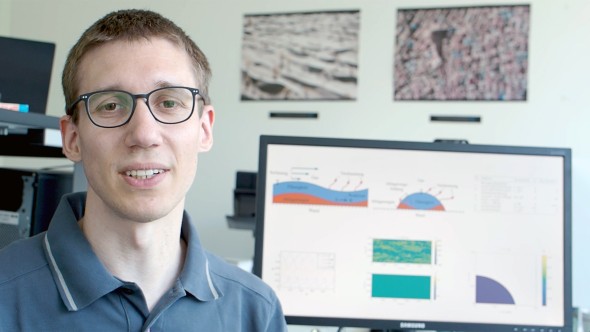Team
| Name | Contact | |
|---|---|---|

| Apl. Prof. Dr. Tatiana Gambaryan-Roisman | gtatiana@ttd.tu-... +49 6151 16-22264 L2|06 201 |

| Lorenzo Vianello M.Sc. | vianello@ttd.tu-... +49 6151 16-20472 L2|06 215 |
Motivation
Diesel and gasoline fuels are known to form wall films inside an internal combustion engine under certain conditions. Highly volatile fuel components evaporate more quickly. The remaining components can create deposits on the wall through cross-linking or chemical reactions. These deposits impair the engine efficiency and increase the emission of pollutants. Deposits can also occur through evaporation in urea injection systems for exhaust gas treatment and interfere with the catalytic process.
Despite their importance, the process sequence and the dependence on different parameters remain unknown.
Objectives
The goal of this subproject is to investigate evaporation of multi-component liquids from complex structures as well as the formation of deposits theoretically and numerically. Models for the description of hydrodynamics, transport processes, chemical reactions, and phase change in liquid films and sessile drops, which are relevant to the studied phenomenon, have been developed in the first funding period.
Additionally, a model for the deposit formation from urea-water solutions was developed and tested successfully. An understanding of the role of hydrodynamics and the heat- and mass transport in an overall complex chemical-physical process has been achieved.
In the second funding period the model will be extended to investigation of deposit formation from exemplary model fuels. The turbulent multiphase flows will be simulated and the results will be compared with experimental data. Furthermore, the developed submodels for film flow, evaporation, and chemical reactions will be combined into a global model. The influence of different physical parameters on film evolution and deposit formation will be investigated with extensive parametric studies
Previous Findings
Specialized methods have been developed to model the coupled film flow, heat transport, mass transport, chemical reactions, and deposit formation both for engine and exhaust pipe conditions. Using the newly developed models, the understanding of the process has been significantly enhanced. It was found that the wall temperature and initial concentration of urea in solution strongly influence the onset instant and growth rate of deposit formation. Furthermore, it has been shown that the thinning kinetics of an evaporating liquid film on a substrate with topography modified by deposits is governed by a complex interaction between the evaporation kinetics and Marangoni convection.
Approach
The main goal of this subproject is modelling and simulation of hydrodynamics and transport processes in thin liquid films and sessile drops, as well as the formation of deposits. In a first step the key physical phenomena are studied individually before they are incorporated into coupled models. The liquid flow, heat and mass transport in the presence of chemical reactions are described using asymptotic models and numerical simulations. The strengths of the different models are combined to gain insight into the complex process.
Long-Wave-Theory (LWT) is used for asymptotic modelling. The validity of the LWT-hypothesis is dependent on fluid properties, film thickness and local gas flow. Important physical phenomena and their interactions can be identified using LWT. Additionally, the computational cost of this method is comparably low, which makes it suitable for the development of an overall film model. This model can in future be used in other subprojects within the Collaborative Research Centre.
Numerical simulations are used to describe the evaporation of multi-component-systems and deposit formation beyond the validity range of the asymptotic method. A volume-of-fluid-method (VOF) is used to investigate the heat transfer in a film sheared by a turbulent gas flow, while a finite element method (FEM/ALE) with a moving mesh framework is used to model drop evaporation and deposit formation. The findings from these models are then compared with the results of experimental work and used for the development of strategies and process parameters towards avoiding deposit formation.


Current Work
Current objectives include the extension of the model for drop evaporation and deposit formation to engine conditions. Additionally, the various asymptotic models developed in the first funding period will be incorporated into one model for film evolution, evaporation, and chemical reactions. Lastly, parametric studies will be conducted to identify critical parameter ranges that lead to deposit formation.
Cooperations
Models and simulation data will be made available for further use in the Collaborative Research Centre.
The developed models will be validated against and compared with experimental data from subproject A01. Process and boundary conditions will be matched between experiment and simulation. Film thickness measurements and concentration profiles gathered in A05 will be used.
The reduced reaction models from B07 will be used in this subproject to investigate deposit formation. The models developed in this subproject will be used for the development of the overall computational model for exhaust pipe (C05) and later for in-cylinder engine conditions (C03).





